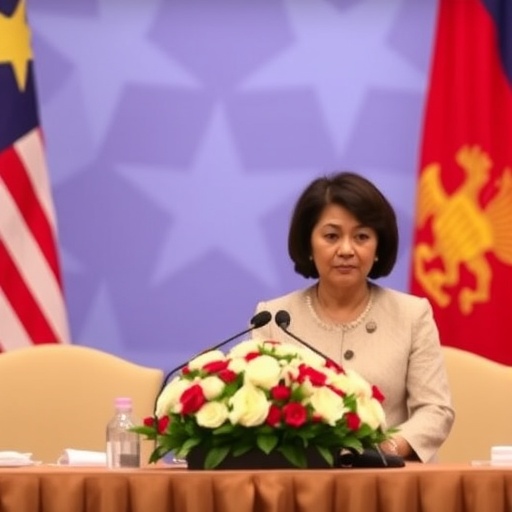Malaysia Warns of Escalating Global Political Turbulence at ASEAN Summit, Urging Regional Unity Amid Geopolitical Storms
In a stark address that reverberated through the halls of the ASEAN Summit in Jakarta, Malaysian Foreign Minister Mohamad Hasan delivered a sobering warning: the world is plunging deeper into political instability, and Southeast Asia stands at the epicenter of these gathering storms. As superpowers clash and alliances fracture, Hasan called on ASEAN nations to fortify their unity, emphasizing that only through collective resolve can the region navigate the intensifying geopolitical rivalries threatening economic stability and security.
- Malaysian Foreign Minister Spotlights Surging Geopolitical Rivalries Threatening ASEAN Stability
- ASEAN Leaders Rally for Unity as Global Politics Tests Regional Bonds
- Spotlight on Key Challenges: How Global Instability is Reshaping Southeast Asia’s Landscape
- Fellow ASEAN Nations Voice Support and Outline Collaborative Strategies
- Charting ASEAN’s Path Forward: Implications for Regional Resilience in Turbulent Times
The summit, attended by leaders from all 10 ASEAN member states, comes at a pivotal moment. With global politics marked by escalating tensions— from the protracted Russia-Ukraine conflict to U.S.-China trade frictions and Middle East flare-ups—Hasan’s words underscore Malaysia‘s growing concerns about spillover effects on the region. “The turbulence in global politics is not a distant storm; it’s already lashing our shores,” Hasan stated, his tone laced with urgency. This declaration sets the stage for deeper discussions on how ASEAN can safeguard its hard-won progress amid these uncertainties.
Malaysian Foreign Minister Spotlights Surging Geopolitical Rivalries Threatening ASEAN Stability
Malaysian Foreign Minister Mohamad Hasan’s keynote speech at the ASEAN Summit painted a vivid picture of a world unraveling under the weight of geopolitical rivalries. Drawing on recent events, he pointed to the intensifying U.S.-China competition in the South China Sea as a prime example of how global politics directly imperils Southeast Asia. “Rivalries that once seemed confined to boardrooms and battlefields are now reshaping trade routes and diplomatic ties in our backyard,” Hasan remarked, highlighting Malaysia‘s strategic position along vital maritime corridors.
Hasan’s cautionary tone was backed by concrete data. According to a recent report from the ASEAN Secretariat, regional trade volumes, which reached $3.6 trillion in 2023, face potential disruptions from supply chain vulnerabilities exacerbated by global instability. Malaysia, as a key exporter of electronics and palm oil, has already felt the pinch: its GDP growth slowed to 4.2% in the first half of 2024, partly due to fluctuating commodity prices tied to international conflicts. The minister urged fellow ASEAN leaders to recognize these interconnections, warning that fragmented responses could amplify economic shocks across the bloc.
Delving deeper, Hasan referenced the summit’s agenda, which includes sessions on maritime security and economic resilience. He advocated for enhanced intelligence-sharing mechanisms among member states to counter hybrid threats like cyberattacks, which have surged 30% in the region over the past year, per cybersecurity firm reports. This focus on proactive measures reflects Malaysia’s leadership role, as the nation chairs ASEAN’s political-security community pillar this year.
ASEAN Leaders Rally for Unity as Global Politics Tests Regional Bonds
The call for unity echoed loudly throughout the ASEAN Summit, with Malaysian Foreign Minister Mohamad Hasan’s plea resonating among delegates grappling with the realities of global politics. In a region home to over 670 million people and boasting a combined GDP of $3.6 trillion, ASEAN’s strength has historically lain in its non-interference principle and consensus-driven approach. Yet, as Hasan noted, “Unity is not just a slogan; it’s our shield against the tempests of international discord.”
Supporting Hasan’s stance, Indonesian President Joko Widodo, the summit’s host, affirmed the need for a “united front” in his opening remarks. “ASEAN must stand firm, leveraging our centrality to bridge divides in global politics,” Widodo said, alluding to the bloc’s role in forums like the UN and G20. This sentiment was mirrored in bilateral talks, where leaders from Vietnam and the Philippines expressed concerns over territorial disputes in the South China Sea, where China’s assertive claims have heightened tensions with multiple ASEAN states.
To illustrate the stakes, consider the economic interdependencies: Intra-ASEAN trade accounts for 25% of the bloc’s total commerce, but external factors like the U.S. Inflation Reduction Act and EU carbon border taxes are pressuring supply chains. Hasan’s address included a proposal for an ASEAN Unity Fund, aimed at pooling resources for crisis response— a $500 million initiative to bolster food security and digital infrastructure. Statistics from the World Bank underscore the urgency: Without unified action, the region could lose up to 2% of GDP annually to geopolitical disruptions by 2030.
Grassroots voices also amplified the unity theme. Civil society representatives at the summit fringe events shared stories of how global instability affects local communities—from Myanmar’s ongoing crisis spilling refugees into neighboring Thailand and Malaysia to climate migration driven by conflicts elsewhere. These narratives humanized Hasan’s warnings, reminding leaders that unity translates to tangible protections for ordinary citizens.
Spotlight on Key Challenges: How Global Instability is Reshaping Southeast Asia’s Landscape
As Malaysian Foreign Minister Mohamad Hasan laid bare the challenges of global politics at the ASEAN Summit, the discussions zeroed in on specific threats that could upend Southeast Asia’s trajectory. Foremost among these is the weaponization of trade, where sanctions and tariffs from major powers like the U.S. and China have created ripple effects. For instance, Malaysia’s semiconductor industry, which contributes 7% to its GDP, has seen export delays due to U.S. restrictions on tech transfers to China, a key market.
Another pressing issue is energy security. The Russia-Ukraine war has driven up global oil prices, impacting ASEAN’s import-dependent economies. Brunei and Malaysia, as oil producers, face volatile revenues, while net importers like the Philippines and Thailand contend with inflation rates that spiked to 6.1% in 2023. Hasan’s speech highlighted the need for diversified energy sources, proposing ASEAN-wide investments in renewables to reduce vulnerability—a move supported by a recent study from the International Energy Agency predicting that the region could meet 23% of its energy needs from solar by 2030 if collaborative efforts intensify.
Security dimensions were not overlooked. The summit addressed the rise of non-state actors and cyber threats, with Hasan citing a 2024 Interpol report showing a 40% increase in ransomware attacks targeting ASEAN ports. In response, working groups formed to develop a regional cybersecurity framework, drawing on Malaysia’s expertise in digital governance. Additionally, the protracted humanitarian crisis in Myanmar was a focal point; Hasan’s call for unity included pleas for mediated dialogues, as border tensions affect trade flows worth billions.
Environmental factors intertwined with geopolitics also featured prominently. Global politics has stalled climate negotiations, leaving ASEAN exposed to rising sea levels and extreme weather. Malaysia, with its extensive coastlines, reported $1.2 billion in damages from 2023 floods, partly worsened by delayed international aid. Hasan’s address pushed for ASEAN to lead on green diplomacy, forging ties beyond traditional rivals to secure climate finance from global funds.
Fellow ASEAN Nations Voice Support and Outline Collaborative Strategies
Reactions from other ASEAN members to Malaysian Foreign Minister Mohamad Hasan’s summit warnings were overwhelmingly supportive, signaling a collective resolve to tackle global politics’ encroachments. Singapore’s Foreign Minister Vivian Balakrishnan praised Hasan’s “timely realism,” stating, “In an era of flux, ASEAN’s unity is our greatest asset against fragmentation.” This endorsement came during a plenary session where strategies for economic decoupling from volatile global supply chains were debated.
Thailand, represented by its Foreign Minister Parnpree Bahiddha-Nukara, emphasized practical steps, including joint military exercises to enhance maritime domain awareness. “Global instability demands that we pool our resources,” Parnpree noted, referencing Thailand’s role in hosting ASEAN defense ministers’ meetings. Meanwhile, Vietnam’s delegation highlighted its experiences with U.S.-China dynamics, advocating for a balanced approach that preserves ASEAN’s strategic autonomy.
The Philippines, under President Ferdinand Marcos Jr., brought a personal angle, sharing how territorial disputes have strained local fisheries and tourism. “Unity means standing together against encroachments,” Marcos declared, aligning with Hasan’s vision. Collaborative initiatives announced include a digital trade corridor project, valued at $2 billion, to streamline cross-border e-commerce and mitigate tariff wars’ impacts.
Cambodia and Laos, often seen as more aligned with China, expressed nuanced support, focusing on infrastructure resilience. A joint statement from the summit outlined 10 priority actions, from harmonizing trade policies to expanding people-to-people exchanges, aiming to inject $10 billion into regional connectivity projects over the next five years.
Charting ASEAN’s Path Forward: Implications for Regional Resilience in Turbulent Times
Looking ahead, Malaysian Foreign Minister Mohamad Hasan’s warnings at the ASEAN Summit pave the way for a more resilient Southeast Asia, with implications that extend far beyond the conference rooms. As global politics continues to evolve—with potential escalations in the Taiwan Strait or renewed Middle East conflicts—ASEAN’s unity will be tested like never before. Experts predict that fortified regional mechanisms could shield the bloc from up to 15% of projected economic losses, according to a 2024 ASEAN Economic Community report.
Next steps include implementing the summit’s outcomes through annual reviews, starting with a unity summit in Malaysia in 2025. This gathering will assess progress on key fronts: economic diversification, where ASEAN aims to boost intra-regional investment by 20%; security pacts, including a proposed ASEAN Peacekeeping Force; and diplomatic outreach to balance relations with global powers.
For Malaysia, the summit reinforces its diplomatic heft, positioning it as a bridge-builder in global politics. Hasan’s final words encapsulated the optimism: “By embracing unity, ASEAN can not only weather the turbulence but emerge stronger, shaping a stable future for our peoples.” As delegates depart Jakarta, the onus is on translating rhetoric into action, ensuring that Southeast Asia’s story is one of collective triumph over adversity.
The broader implications ripple globally. A unified ASEAN could influence international norms on trade and security, offering a model for multilateralism in an era of division. Stakeholders from businesses to NGOs are watching closely, ready to support initiatives that promise sustainable growth. In the end, Hasan’s cautionary tale serves as a clarion call: In the face of rising global political turbulence, unity isn’t optional—it’s essential for survival and prosperity.








